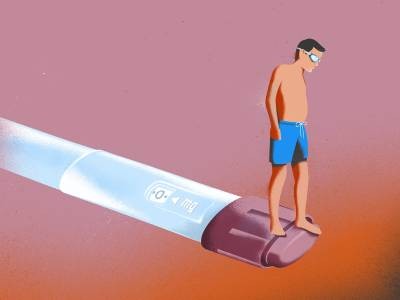
Drugs such as Ozempic and Mounjaro act on GLP-1 receptors in the brain to regulate appetite. Credit: Oliver Berg/dpa via Alamy
The obesity drug tirzepatide, sold as Mounjaro or Zepbound, can suppress patterns of brain activity associated with food cravings, a study suggests. Researchers measured the changing electrical signals in the brain of a person with severe obesity who had experienced persistent ‘food noise’ — intrusive, compulsive thoughts about eating — shortly after the individual began taking the medication.
The study is the first to use electrodes to directly measure how blockbuster obesity drugs that mimic the hormone GLP-1 affect brain activity in people, and to hint at how they curb extreme food cravings.
“It’s a great strategy to try and find a neural signature of food noise, and then try to understand how drugs can manipulate it,” says Amber Alhadeff, a neuroscientist at the Monell Chemical Senses Center in Philadelphia, Pennsylvania. The findings were published today in Nature Medicine1.
Bonus finding
Casey Halpern, a neurosurgeon-scientist at the University of Pennsylvania in Philadelphia, and his colleagues did not set out to investigate the effects of obesity drugs on the brain. The team’s goal was to test whether a type of deep brain stimulation — a therapy that involves delivering a weak electrical current directly into the brain — can help to reduce compulsive eating in people with obesity for whom treatments such as bariatric surgery haven’t worked.
How to keep weight off after obesity drugs
The scientists set up a study in which participants had an electrode implanted into their nucleus accumbens, a region of the brain that is involved in feelings of reward. It also expresses the GLP-1 receptor, notes Christian Hölscher, a neuroscientist at the Henan Academy of Innovations in Medical Science in Zhengzhou, China, “so we know that GLP-1 plays a role in modulating reward here”. This type of electrode, which can both record electrical activity and deliver an electrical current when needed, is already used in people to treat some forms of epilepsy.
For the study’s first two participants, the researchers found that episodes of intense food noise were accompanied by a surge in low-frequency brain activity. This pattern suggested that these changes could serve as a measurable sign of compulsive food cravings.
The third trial participant, a 60-year-old woman, had just started taking a high dose of tirzepatide — which had been prescribed by her physician to treat type 2 diabetes — when she had the electrode implanted. “We took advantage of this serendipitous opportunity because of the excitement around these drugs,” Halpern says.



